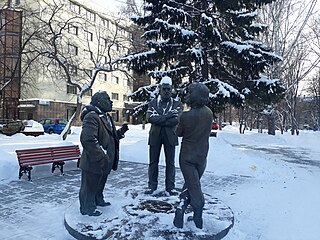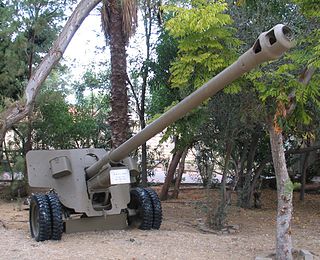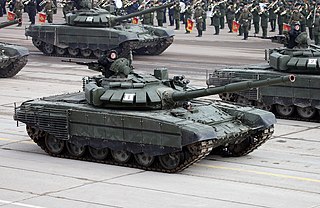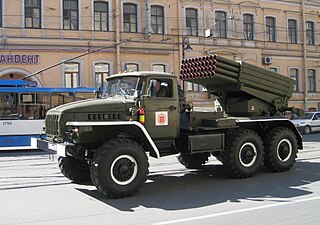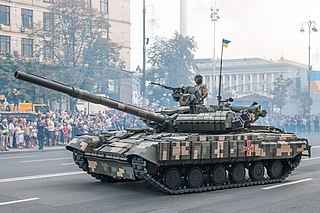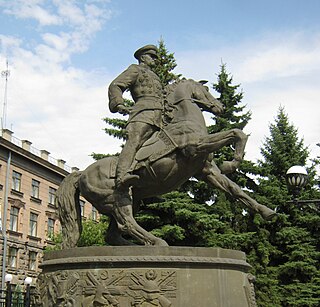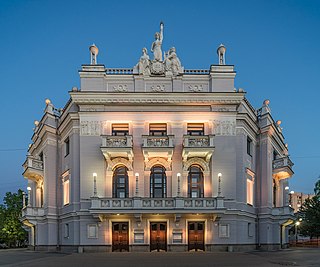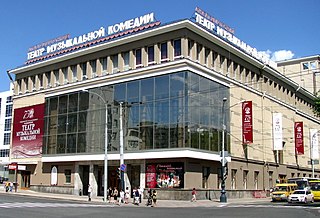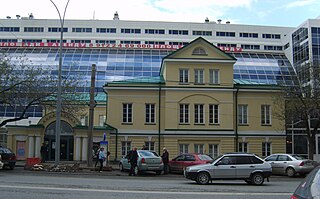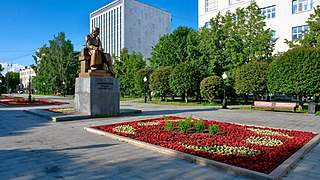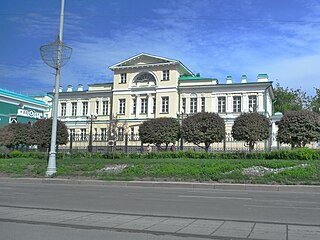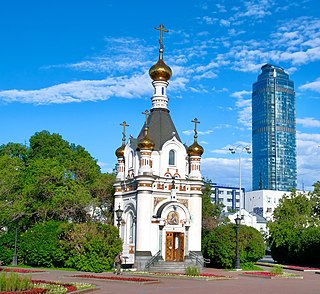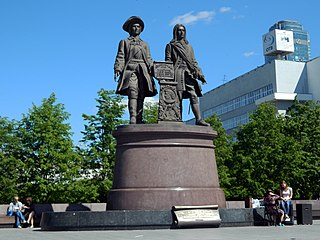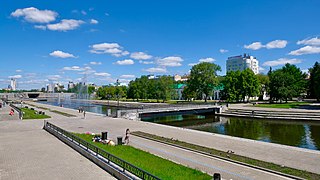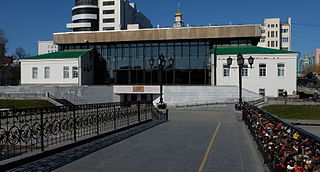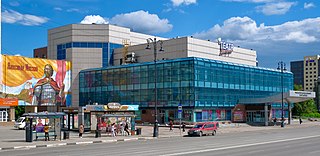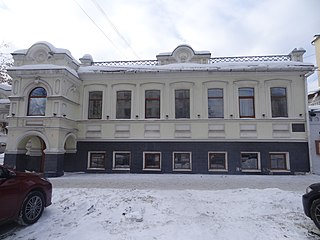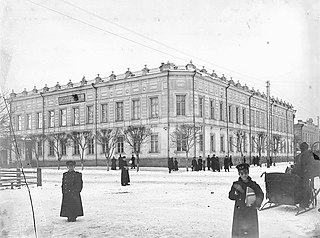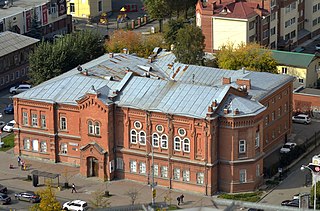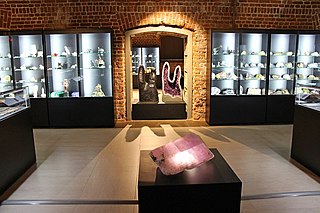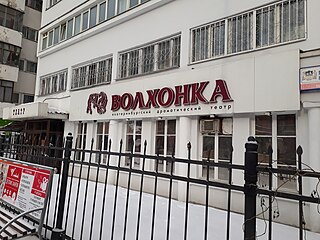Self-guided Sightseeing Tour #3 in Yekaterinburg, Russia
Legend
Tour Facts
5.8 km
86 m
Experience Yekaterinburg in Russia in a whole new way with our free self-guided sightseeing tour. This site not only offers you practical information and insider tips, but also a rich variety of activities and sights you shouldn't miss. Whether you love art and culture, want to explore historical sites or simply want to experience the vibrant atmosphere of a lively city - you'll find everything you need for your personal adventure here.
Individual Sights in YekaterinburgSight 1: Горожане. Разговор
"Citizens. Conversation" is a monument located in Yekaterinburg, in a park at the corner of Lenin Avenue and Michurin Street. It was opened on August 18, 2008. The author is Andrey Antonov.
Sight 2: БС-3
The 100 mm field gun M1944 (BS-3) is a Soviet 100 mm (3.9 in) anti-tank and field gun.
Sight 3: Т-80
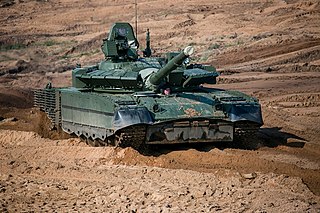
The T-80 is a main battle tank (MBT) that was designed and manufactured in the former Soviet Union and manufactured in Russia. The T-80 is based on the T-64, while incorporating features from the later T-72 and changing the engine to a gas turbine. When it entered service in 1976, it was the first production tank to be powered solely by turbine.
Sight 4: Т-72
The T-72 is a family of Soviet main battle tanks that entered production in 1973. The T-72 was a development based on the T-64 using thought and design of the previous Object 167M. About 25,000 T-72 tanks have been built, and refurbishment has enabled many to remain in service for decades. It has been widely exported and has seen service in 40 countries and in numerous conflicts. The Russian T-90 introduced in 1992 and the Chinese Type 99 are further developments of the T-72. Production and development of various modernized T-72 models continues today. Currently holds the record for the most MBT's lost in combat.
Sight 5: РСЗО
The BM-21 "Grad" is a self-propelled 122 mm multiple rocket launcher designed in the Soviet Union. The system and the M-21OF rocket were first developed in the early 1960s, and saw their first combat use in March 1969 during the Sino-Soviet border conflict. BM stands for boyevaya mashina, and the nickname grad means "hail". The complete system with the BM-21 launch vehicle and the M-21OF rocket is designated as the M-21 field-rocket system and is more commonly known as a Grad multiple rocket launcher system.
Sight 6: Т-64
The T-64 is a Soviet tank manufactured in Kharkiv, and designed by Alexander Morozov. The tank was introduced in the early 1960s. It was a more advanced counterpart to the T-62: the T-64 served in tank divisions, while the T-62 supported infantry in motor rifle divisions. It introduced a number of advanced features including composite armour, a compact engine and transmission, and a smoothbore 125-mm gun equipped with an autoloader to allow the crew to be reduced to three so the tank could be smaller and lighter. In spite of being armed and armoured like a heavy tank, the T-64 weighed only 38 tonnes.
Sight 7: Г. К. Жукову
The monument to Marshal Zhukov is an equestrian statue of Soviet commander Georgy Zhukov in Yekaterinburg. It was erected on May 8, 1995 in front of the headquarters building of the Central Military District. In 2021, another sculptural monument to Zhukov was unveiled next to it, depicting the commander sitting in a car.
Sight 8: Театр оперы и балета
The Yekaterinburg State Academic Opera and Balet Theater is a stationary opera and ballet theater in Yekaterinburg, founded in 1912. The building was designed by engineer V. N. Semyonov. It was here that on November 8, 1917, at an emergency meeting of the Yekaterinburg Soviet of Workers' and Soldiers' Deputies, the establishment of Soviet power in the city and in the Urals was announced.
Sight 9: Театр музыкальной комедии
The Sverdlovsk State Academic Theater of Music Comesia - the Musical Theater in Yekaterinburg, was founded in 1933, since 1986 - academic. One of the leading theaters of Russia, the multiple holder of the National Theater Prize "Golden Mask".
Wikipedia: Свердловский государственный академический театр музыкальной комедии (RU), Website
Sight 10: Ekaterinburg History Museum
The Museum of the History of Yekaterinburg is located in several old buildings in the historical center of the city at 26 Karl Liebknecht Street. In the building in which in 1905 there was an illegal school of party propagandists, organized by Sverdlov Yakov Mikhailovich.
Sight 11: Памятник А. С. Пушкину
A. S. Pushkin never visited Yekaterinburg, but his memory is kept here as well. In 1899, in connection with the centenary of the poet, Pushkinskaya Street appeared in the city.
Sight 12: A. S. Popov
The monument to Alexander Stepanovich Popov in Yekaterinburg is installed in the city center, in the square named after him.
Sight 13: Museum of Stone-Rain and Jewelry Art
The Museum of the History of Stone-Carving and Jewelry Art in Yekaterinburg is the first museum of this kind in Russia, established in 1992.
Wikipedia: Музей истории камнерезного и ювелирного искусства (RU), Website
Sight 14: Часовня Святой Екатерины
St. Catherine's Chapel is an Orthodox chapel in Yekaterinburg on Truda Square. It was built in 1997-1998 by the architect A. V. Dolgov on the site of the Catherine Cathedral, blown up in 1930.
Sight 15: В. Н. Татищеву и В. де Геннину
The monument to Vasily Tatishchev and Wilhelm de Gennin is located in Yekaterinburg on Labor Square.
Sight 16: Water Tower
The water tower in the historical square is an architectural monument of federal significance. It was built no earlier than 1891 for the needs of railway workshops. From 1947 to the 1960s. The tower was actually a two -apartment residential building. Since 1995, a branch of the Museum of History of Yekaterinburg. After the capital reconstruction of 2017-2018, a souvenir shop, a guest center and a coffee shop opened on the ground floor. Since November 2018, a museum exposition has been working on the second floor dedicated to the history of the dam and the tower.
Sight 17: №9 Historical Square
Historical Square is a square in Yekaterinburg, laid out in 1973 - for the 250th anniversary of the city. It is located on the site of the former Yekaterinburg plant, founded in 1723 and which gave rise to the city. Most of the former factory buildings were demolished during the reconstruction of 1964-1973, and several museums are now located in the surviving buildings.
Sight 18: Ekaterinburg Museum of Fine Arts
The Yekaterinburg Museum of Fine Arts, established in 1986, is the largest art museum of the Urals region of Russia. It is based in Voevodina Street on the banks of the Iset River in the city of Yekaterinburg.
Sight 19: Уральский государственный Театр Эстрады
The Ural State Variety Theater is a theater in Yekaterinburg, Russia, founded in 1996 by decree of the Governor of the Sverdlovsk Region. It was opened on February 1, 1997.
Sight 20: Actor's House
Actor's house is an architectural monument, a two -story chamber palace of the late XIX century, built according to the project of architect Julia Dutel. In 1988, the actor’s house became the official residence of the Sverdlovsk branch of the Union of Theater Workers of Russia. At the expense of the theater community in the 1980s. The historical appearance was completely restored, up to a unique ancient parquet, whose drawing is not repeated in any of the rooms, and a large fireplace - a masterpiece of stone -real art. The actor’s house is now a public cultural center, collecting in its walls not only the theater public of the city and the region, but also all lovers of theatrical art. Creative cycles and programs constantly work here. The most noticeable of them are the author’s cycle of Mikhail Muginstein “400 years of opera”, the student club “The School of Theater Critics”, uniting young lovers of the theater, “Open Scene”, which gives artists of different theaters to unite for joint creative work. The most famous project of the actor’s house is the famous family holidays in the best traditions of Russian mansions, philanthropy and charity “Christmas tree in the Dullfish House” - stylized representations in the old style that go in the actor’s house in New Year's days and are created by leading creative forces of the city.
Sight 21: Екатеринбургское реальное училище
The Yekaterinburg (Alekseevsky) Real School was a secondary educational institution in Yekaterinburg in 1873-1919, designed to promote the spread of the so-called real education, which was a type of general secondary education with a practical orientation.
Sight 22: Здание пансиона и церкви Алексеевского реального училища
The building of the boarding school and the church of the Alekseevsky Real School is located in the historical center of Yekaterinburg, is an architectural monument, located at 13 Lenin Avenue.
Wikipedia: Здание пансиона и церкви Алексеевского реального училища (RU)
Sight 23: Музей камня
The Ural Mineralogical Museum of V. A. Pelepenko is a private mineralogical museum located in Yekaterinburg from 2000 to 2015 in the building of the Bolshoi Ural Hotel. In 2017-2018, he was in Pervouralsk at the Innovative Cultural Center ("puck"). Since 2018, the museum's exposition has been located in Yekaterinburg at the Main Prospekt Arts Center at 8 Lenin Avenue.
Wikipedia: Уральский минералогический музей В. А. Пелепенко (RU), Website
Sight 24: Театр Волхонка
The Yekaterinburg Drama Theater "Volkhonka" is a chamber theater inviting different directors.
Share
How likely are you to recommend us?
Disclaimer Please be aware of your surroundings and do not enter private property. We are not liable for any damages that occur during the tours.
GPX-Download For navigation apps and GPS devices you can download the tour as a GPX file.
